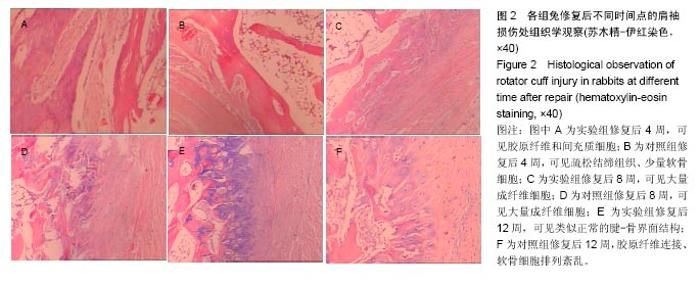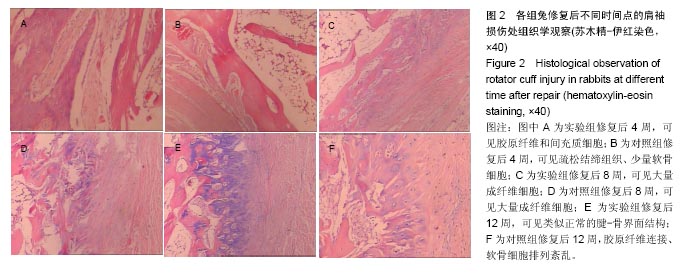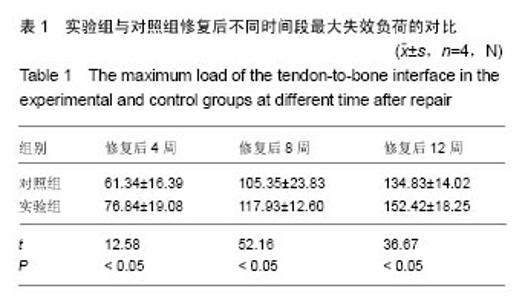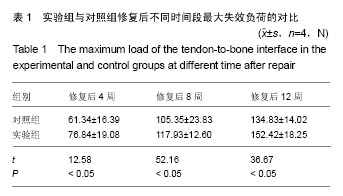Chinese Journal of Tissue Engineering Research ›› 2017, Vol. 21 ›› Issue (30): 4847-4751.doi: 10.3969/j.issn.2095-4344.2017.30.016
Previous Articles Next Articles
Autologous periosteum patch enhances tendon-bone healing in rotator cuff repair
- 1Department of Joint Surgery, 2Department of Pathology, Affiliated Hospital of Chengde Medical University, Chengde 067000, Hebei Province, China
-
Received:2017-05-17Online:2017-10-28Published:2017-11-07 -
Contact:Zhao Yang, Master, Attending physician, Department of Pathology, Affiliated Hospital of Chengde Medical University, Chengde 067000, Hebei Province, China -
About author:Li Jia, Master, Attending physician, Department of Joint Surgery, Affiliated Hospital of Chengde Medical University, Chengde 067000, Hebei Province, China
CLC Number:
Cite this article
Li Jia, Dai Hai-feng, Liu Sha-sha, Xu Cong, Zhao Yang. Autologous periosteum patch enhances tendon-bone healing in rotator cuff repair[J]. Chinese Journal of Tissue Engineering Research, 2017, 21(30): 4847-4751.
share this article

2.1 实验动物数量分析 48只新西兰白兔存活良好,术后无感染及意外死亡发生,均达到实验取材标准。 2.2 两组标本大体观察结果 实验组修复后4周冈上肌肌腱止点未愈合,局部瘢痕组织形成包裹,骨膜补片部分溶解;修复后8周,骨膜补片与冈上肌肌腱紧密连接,边界不清,腱骨止点覆盖满意;修复后12周骨膜补片与冈上肌肌腱完全融合,止点可见类似正常的连续腱骨连接。对照组修复后4周仍可见断端裂隙存在,无组织生长;修复后8周,可见瘢痕组织被膜覆盖;修复后12周时,仅可见瘢痕组织包裹,腱骨连接处仍有间隙存在。 2.3 两组组织学观察结果 实验组修复后4周可见大量胶原纤维连接(Sharpey纤维)和炎性细胞浸润,间充质细胞增生明显,少量软骨细胞(图2A);修复后8周,可见膜内化骨,大量新生软骨细胞,排列不规整(图2C);修复后12周,肌腱与骨结合紧密,无间隙,软骨细胞排列规整,类似正常的腱骨界面结构(图2E)。对照组修复4周可见疏松结缔组织填充(图2B);修复后8周,止点处可见大量成纤维细胞,少量胶原纤维连接,少量软骨细胞形成(图2D);修复后12周,可见胶原纤维连接,软骨细胞排列紊乱(图2F)。"

| [1]Bishop J,Klepps S,Lo IK,et al.Cuff integrity after arthroscopic versus open rotator cuff repair: a prospective study.J Shoulder Elbow Surg.2006;15(3):290-299.[2]Lorbach O, Baums MH, Kostuj T, et al. Advances in biology and mechanics of rotator cuff repair.Knee Surg Sports Traumatol Arthrosc.2015;23(2):530-541.[3]Al-Hakim W,Noorani A,Lambert S.Assessment and treatment strategies for rotator cuff tears.Shoulder Elbow.2015;7(2): 76-84.[4]李小溪,赵金忠.细胞工程技术在肩袖损伤修复中的应用[J].中华骨科杂志, 2015,35(6):681-685.[5]Lannotti JP,Codsi MJ,Kwon YW,et al.Porcine small intestine submucosa augmentation of surgical repair of chronic two-tendon rotator cuff tears. A randomized ,controlled trial.J Bone Joint Surg Am.2006;88(6):1238-1244.[6]张颉鸿,吴海山.肩袖修复后促进腱骨界面软骨再生的研究进展[J].中国矫形外科杂志, 2016, 24(14):1299-1303.[7]Thangarajah T,Pendegrass CJ,Shahbazi S,et al. Augmentation of rotator cuff repair with soft tissue scaffolds. Orthop J Sports Med.2015;3(6):1-8.[8]Carvalho AL,Martinelli F,Tramujas L,et al.Rotator cuff injuries and factors associated with reoperation.Rev Bras Ortop. 2016;51(3):298-302.[9]Sevivas N,Serra SC,Portugal R,et al.Animal model for chronic massive rotator cuff tear: behavioural and histologic analysis. Knee Surg Sports Traumatol Arthrosc.2015; 23(2):608-618.[10]Lee HJ,Kim YS,Ok JH,et al.Effect of a single subacromial prednisolone injection in acute rotator cuff tears in a rat model.Knee Surg Sports Traumatol Arthrosc.2015; 23(2):555-561.[11]Lorbach O,Baums MH,Kostuj T,et al.Advances in biology and mechanics of rotator cuff repair.Knee Surg Sports Traumatol Arthrosc.2015;23(2):530-541.[12]Mori D,Funakoshi N,Yamashita F.Arthroscopic surgery of irreparable large or massive rotator cuff tears with low-grade fatty degeneration of the infraspinatus: patch autograft procedure versus partial repair procedure.Arthroscopy. 2013;29(12): 1911-1921.[13]Ciampi P,Scotti C,Nonis A,et al.The benefit of synthetic versus biological patch augmentation in the repair of posterosuperior massive rotator cuff tears a 3-year follow-up study.Am J Sports Med.2014;42:1169-1175.[14]Wong I,Burns J,Snyder S.Arthroscopic graftJacket repair of rotator cuff tear.J Shoulder Elbow Surg.2010;19(2 Suppl): 104-109.[15]Milgrom C,Schaffler M,Gilbert S,et al.Rotator-cuff changes in asymptomatic adults. The effect of age, hand dominance and gender.J Bone Joint Surg Br.1995;77(2):296-298.[16]Murray TF Jr,Lajtai G,Mileski RM,et al.Arthroscopic repair of medium to large full-thickness rotaor cuff tears:outcome at 2-to 6-year follow—up.J Shoulder Elbow Surg.2002;11(1):19-24.[17]Wlk MV,Abdelkafy A,Hexel M,et al.Biomechanical evaluation of suture–tendon interface and tissue holding of three suture configurations in torn and degenerated versus intact human rotator cuffs.Knee Surg Sports Traumatol Arthrosc. 2015; 23(2):386-392.[18]Breidenbach AP, Gilday SD, Lalley AL,et al.Functional tissue engineering of tendon: establishing biological success criteria for improving tendon repair.J Biomech.2014;47(9):1941-1948.[19]Ross D,Maerz T,Kurdziel M,et al.The effect of granulocyte-colony stimulating factor on rotator cuff healing after injury and repair. Clin orthop Relat Res.2015;473(5):1655-1664.[20]Jo CH,Shin JS,Shin WH,et al.Platelet-Rich Plasma for Arthroscopic Repair of Medium to Large Rotator Cuff Tears. Am J Sports Med.2015;43(9):2102-2110.[21]Kabiri A,Esfandiari E,Esmaeili A,et al.Platelet-rich plasma application in chondrogenesis.Adv Biomed Res. 2014;25(3): 138.[22]Antuna S,Barco R,Martinez Diez JM,et al.Platelet rich fibrin in arthroscopic repair of massive rotator cuff tears:A prospective randomized pilot clinical trial.Acta Orthop Belg. 2013;79(1):25-30.[23]Ciampi P,Scotti C,Nonis A,et al.The benefit of synthetic versus biological patch augmentation in the repair of posterosuperior massive rotator cuff tears: A 3-year follow-up study.Am J Sports Med.2014;42(5):1169-1175.[24]Levy O,Relwani J,Zaman T,et al.Measurement of blood flow in the rotator cuff using laser Doppler flowmetry.J Bone Joint Surg Br.2008;90(7):893-898.[25]Kuzel BR,Grindel S,Papandrea R,et a1.Fatty infiltration and rotator cuff atrophy.J Am Acad Orthop Surg.2013;10:613-623.[26]Adams JE,Zobitz ME,Reach JS Jr,et a1.Rotator cuff repak using an acellular dermal matrix graft: an in vivostudy in a canine model.Arthroscopy.2006;22(7):700-709.[27]Hutmacher DW,Sittinger M.Periosteal cells in bone tissue engineering.Tissue Eng. 2003;9(1):S45-S64.[28]张俊玮,陆海涛,杨宇明,等.低温培养对骨膜细胞成软骨分化的影响[J].中华实验外科杂志, 2016,33(5):1281-1283.[29]Deponti D,Di Giancamillo A,Gervaso F,et al.Collagen scaffold for cartilage tissue engineering: the benefit of fibrin glue and the proper culture time in an infant cartilage mode.Tissue Eng Part A.2014;20:1113-1126.[30]Elnikety S,Pendegrass CJ,De Godoy RF,et al.Augmentation and repair of tendons using demineralised cortical bone.BMC Musculoskelet Disord.2016;17(1):483-49.[31]Valencia Mora M,Ruiz lban MA,Diaz Heredia J,et al.Stem cell therapy in the management of shoulder rotator cuff disorders. World J Stem Cells.2015;7(4):691-699.[32]Hernigou P, Flouzat Lachaniette CH, Delambre J,et al. Biologic augmentation of rotator cuff repair with mesenchymal stem cells during arthroscopy improves healing and prevents further tears: a case-controlled study.Int Orthop. 2014; 38(9): 1811-1818.[33]Kim HM,Galatz LM,Das R,et al.The role of transforming growth factor beta isoforms in tendon-to-bone healing. Connect Tissue Res.2011;52(2):87-98.[34]Mara CS,Sartori AR,Duarte AS,et al.Periosteum as a source of mesenchymal stem cells: The effects of TG-3 on chondrogenesis.Clinics(Sao Paulo).2011;66(33):487-492.[35]Beitzel K,Solovyova O,Cote MP,et al.The future role of mesenchymal stem cells in the management of shoulder disorders.Arthroscopy.2013;29(10):1702-1711.[36]张冲,李莉.TGF-β1对大鼠肩袖损伤修复术后腱-骨愈合的影响[J].医用生物力学,2016, 31(2):167-170.[37]Akyol E,Hindocha S,Khan WS.Use of Stem Cells and Growth Factors in Rotator Cuff Tendon Repair.Curr Stem Cell Res Ther. 2015;10(1):5-10.[38]Chen ACY,Lin SS,Chan YS,et al.Osteogenesis of prefabricated vascularized periosteal graft in rabbits.J Trauma. 2009;67(1):165-167. |
| [1] | Yao Xiaoling, Peng Jiancheng, Xu Yuerong, Yang Zhidong, Zhang Shuncong. Variable-angle zero-notch anterior interbody fusion system in the treatment of cervical spondylotic myelopathy: 30-month follow-up [J]. Chinese Journal of Tissue Engineering Research, 2022, 26(9): 1377-1382. |
| [2] | Zhang Jinglin, Leng Min, Zhu Boheng, Wang Hong. Mechanism and application of stem cell-derived exosomes in promoting diabetic wound healing [J]. Chinese Journal of Tissue Engineering Research, 2022, 26(7): 1113-1118. |
| [3] | An Weizheng, He Xiao, Ren Shuai, Liu Jianyu. Potential of muscle-derived stem cells in peripheral nerve regeneration [J]. Chinese Journal of Tissue Engineering Research, 2022, 26(7): 1130-1136. |
| [4] | He Yunying, Li Lingjie, Zhang Shuqi, Li Yuzhou, Yang Sheng, Ji Ping. Method of constructing cell spheroids based on agarose and polyacrylic molds [J]. Chinese Journal of Tissue Engineering Research, 2022, 26(4): 553-559. |
| [5] | He Guanyu, Xu Baoshan, Du Lilong, Zhang Tongxing, Huo Zhenxin, Shen Li. Biomimetic orientated microchannel annulus fibrosus scaffold constructed by silk fibroin [J]. Chinese Journal of Tissue Engineering Research, 2022, 26(4): 560-566. |
| [6] | Chen Xiaoxu, Luo Yaxin, Bi Haoran, Yang Kun. Preparation and application of acellular scaffold in tissue engineering and regenerative medicine [J]. Chinese Journal of Tissue Engineering Research, 2022, 26(4): 591-596. |
| [7] | Kang Kunlong, Wang Xintao. Research hotspot of biological scaffold materials promoting osteogenic differentiation of bone marrow mesenchymal stem cells [J]. Chinese Journal of Tissue Engineering Research, 2022, 26(4): 597-603. |
| [8] | Shen Jiahua, Fu Yong. Application of graphene-based nanomaterials in stem cells [J]. Chinese Journal of Tissue Engineering Research, 2022, 26(4): 604-609. |
| [9] | Zhang Tong, Cai Jinchi, Yuan Zhifa, Zhao Haiyan, Han Xingwen, Wang Wenji. Hyaluronic acid-based composite hydrogel in cartilage injury caused by osteoarthritis: application and mechanism [J]. Chinese Journal of Tissue Engineering Research, 2022, 26(4): 617-625. |
| [10] | Li Hui, Chen Lianglong. Application and characteristics of bone graft materials in the treatment of spinal tuberculosis [J]. Chinese Journal of Tissue Engineering Research, 2022, 26(4): 626-630. |
| [11] | Gao Cangjian, Yang Zhen, Liu Shuyun, Li Hao, Fu Liwei, Zhao Tianyuan, Chen Wei, Liao Zhiyao, Li Pinxue, Sui Xiang, Guo Quanyi. Electrospinning for rotator cuff repair [J]. Chinese Journal of Tissue Engineering Research, 2022, 26(4): 637-642. |
| [12] | Guan Jian, Jia Yanfei, Zhang Baoxin , Zhao Guozhong. Application of 4D bioprinting in tissue engineering [J]. Chinese Journal of Tissue Engineering Research, 2022, 26(3): 446-455. |
| [13] | Liu Jiali, Suo Hairui, Yang Han, Wang Ling, Xu Mingen. Influence of lay-down angles on mechanical properties of three-dimensional printed polycaprolactone scaffolds [J]. Chinese Journal of Tissue Engineering Research, 2022, 10(16): 2612-2617. |
| [14] | Huang Bo, Chen Mingxue, Peng Liqing, Luo Xujiang, Li Huo, Wang Hao, Tian Qinyu, Lu Xiaobo, Liu Shuyun, Guo Quanyi . Fabrication and biocompatibility of injectable gelatin-methacryloyl/cartilage-derived matrix particles composite hydrogel scaffold [J]. Chinese Journal of Tissue Engineering Research, 2022, 10(16): 2600-2606. |
| [15] | Li Xuan, Sun Yimin, Li Longbiao, Wang Zhenming, Yang Jing, Wang Chenglin, Ye Ling. Manufacturing of nano-modified polycaprolactone microspheres and its biological effects in dental pulp cells [J]. Chinese Journal of Tissue Engineering Research, 2022, 26(10): 1530-1536. |
| Viewed | ||||||
|
Full text |
|
|||||
|
Abstract |
|
|||||

